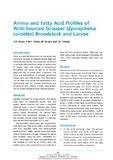Effects of dietary lipid source on reproductive performance and tissue lipid levels of Nile tilapia Oreochromis niloticus (Linnaeus) broodstock
- Global styles
- MLA
- Vancouver
- Elsevier - Harvard
- APA
- Help
Share
Abstract
Nile tilapia were fed diets supplemented with one of the following lipid sources at 5% level: cod liver oil, corn oil, soybean oil, a coconut oil-based cooking oil or a combination of cod liver oil and corn oil (1 : 1). The control diet had no lipid supplement and tad fish meal as a sole protein source. A diet with soybean meal as a protein source was also tested. The number of females that spawned, spawning frequency, number of fry per spawning, and total fry production were increased at varying degrees by the supplemental lipid sources except for the cod liver oil. Fish fed the soybean oil diet tad the best overall reproductive performance over a 24-week period. Fish fed the cod liver oil diet had the highest weight gain but the poorest reproductive performance. The suplemental lipids significantly increased crude fat levels in the liver and ovaries. Both males and females Ld the cod liver oil diet had the highest levels of fat in the liver and muscle. The ratio of total n-6/n-3 fatty acid in the liver, ovaries and testes was influenced by the supplemental lipid sources. It was highest in fish fed either the soybean oil diet, the corn oil diet, or the soybean meal diet and lowest in fish fed the control diet or the cod liver oil diet.
Suggested Citation
Santiago, C. B., & Reyes, O. S. (1993). Effects of dietary lipid source on reproductive performance and tissue lipid levels of Nile tilapia Oreochromis niloticus (Linnaeus) broodstock. Journal of Applied Ichthyology , 9(1), 33-40. https://doi.org/10.1111/j.1439-0426.1993.tb00385.x
Type
ArticleISSN
1439-0426Collections
- Journal Articles [1258]
Related items
Showing items related by title, author, creator and subject.
-
Variation in tissue lipid content and fatty acid composition during ovarian maturation of unablated and ablated Penaeus monodon broodstock
Millamena, Oseni M.; Pudadera, Rosario; Catacutan, Mae R. (Aquaculture Department, Southeast Asian Fisheries Development Center, 1985)The tissue lipid content and fatty acid composition in the hepatopancreas, tail muscle and gonad of unablated and ablated Penaeus monodon were determined. Females at various stages of maturity were collected from offshore ... -
Series: ACIAR Monograph 110
Lipid nutrition studies on grouper (Epinephelus coioides) larvae
Alava, Veronica R.; Priolo, Flora Mae P.; Toledo, Joebert D.; Rodriguez, Jesus C., Jr.; Quinitio, Gerald F.; Sa-an, Analyn C.; de la Peña, Milagros R.; Caturao, Romeo D. (Australian Centre for International Agricultural Research, 2004)The main objectives of this project were to study the lipid chain transfer from the egg stage through hatching and the patterns of lipid conservation or loss during starvation and feeding of larvae in order to elucidate ... -
Series: ACIAR Monograph 110
Amino and fatty acid profiles of wild-sourced grouper (Epinephelus coioides) broodstock and larvae
Alava, Veronica R.; Priolo, Flora Mae P.; Toledo, Joebert D.; Rodriguez, Jesus C., Jr.; Quinitio, Gerald F.; Sa-an, Analyn C.; de la Peña, Milagros R.; Caturao, Romeo D. (Australian Centre for International Agricultural Research, 2004)This study was undertaken to provide information on the levels of amino acids in the muscle, liver and gonad of wild-sourced broodstock and larvae, as well as in neurula eggs and day 35 larvae from a hatchery. The fatty ...





